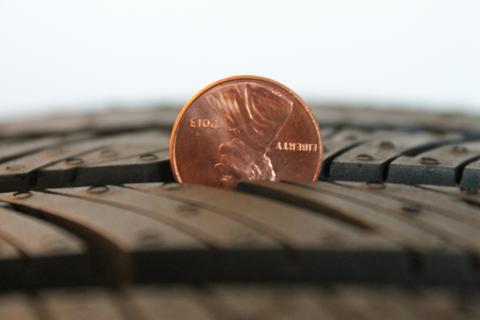Spending just a few minutes each month on maintenance can make all the difference in your tires’ safety, life and performance. You don’t need to be an expert mechanic. Just stick to the four essentials.
Tire Pressure
Proper inflation pressure—perhaps the most important tire condition to monitor—gives tires the ability to support the vehicle and you to control it for maximum performance. Bonus benefit: Maintaining proper inflation pressure maximizes fuel economy, too.
- Under inflated tires generate excessive heat build-up and stress, causing irregular wear and internal damage.
- Over inflated tires are more likely to be cut, punctured or damaged when hitting an obstacle, such as a pothole.
Checking Your Pressure
Use a tire gauge to check inflation pressure, measured in in PSI (pounds per square inch). You’ll find recommended pressure on a label on the driver’s door or in your vehicle owner's manual.
And don’t forget about your spare.
When to Check
Check your tires at least once a month, and check them when they’re cold—meaning parked for at least three hours. Note that inflation pressure increases (in warm weather) or decreases (in cold weather) one to two pounds for every 10 degrees of temperature change.
Also, check your pressure before you head out on any long trips, carry heavy loads or tow a trailer.
Tire Pressure Monitoring Systems
Tire Pressure Monitoring Systems (TPMS) detect loss of inflation pressure and warn drivers when tires are 25% under inflated. For many vehicles, this warning may be too late to prevent damage. TPMS are not a replacement for monthly tire pressure checks with a gauge.
Tread Depth

Tread equals traction—giving your tires a grip on the road, especially in bad weather. Lose too much tread and you could lose control.
Once your tread wears down to 2/32nds of an inch, it’s time to visit your local tire shop. Take a few minutes each month to visually inspect your tires for uneven wear, high and low areas, unusually smooth areas and other signs of damage.
Tires have built-in tread wear indicators, or wear bars. When the tops of these bars are flush with the tire’s tread, the tire needs to be replaced.
Tire Rotation
Rotating your tires based on the recommendations in your vehicle’s owner’s manual can prevent irregular tire wear. If no rotation period is specified, USTMA recommends every 5,000 to 8,000 miles. Once you’re done, make sure the inflation pressure is set to the vehicle manufacturer’s specifications.
Tire Alignment
Striking a pothole or other road hazard could cause alignment issues. Misaligned wheels can lead to uneven, rapid tread wear and should be corrected by a tire dealer. Have your alignment checked at any indication of trouble, such as “pulling,” and periodically, along with your tire balance, as specified by your vehicle’s owner’s manual.
Seasonal Tire Care Tips
As seasons change, so do driving conditions. Prepare for safer travels in all kinds of weather with tire care and driving tips for spring, summer, fall and winter.
